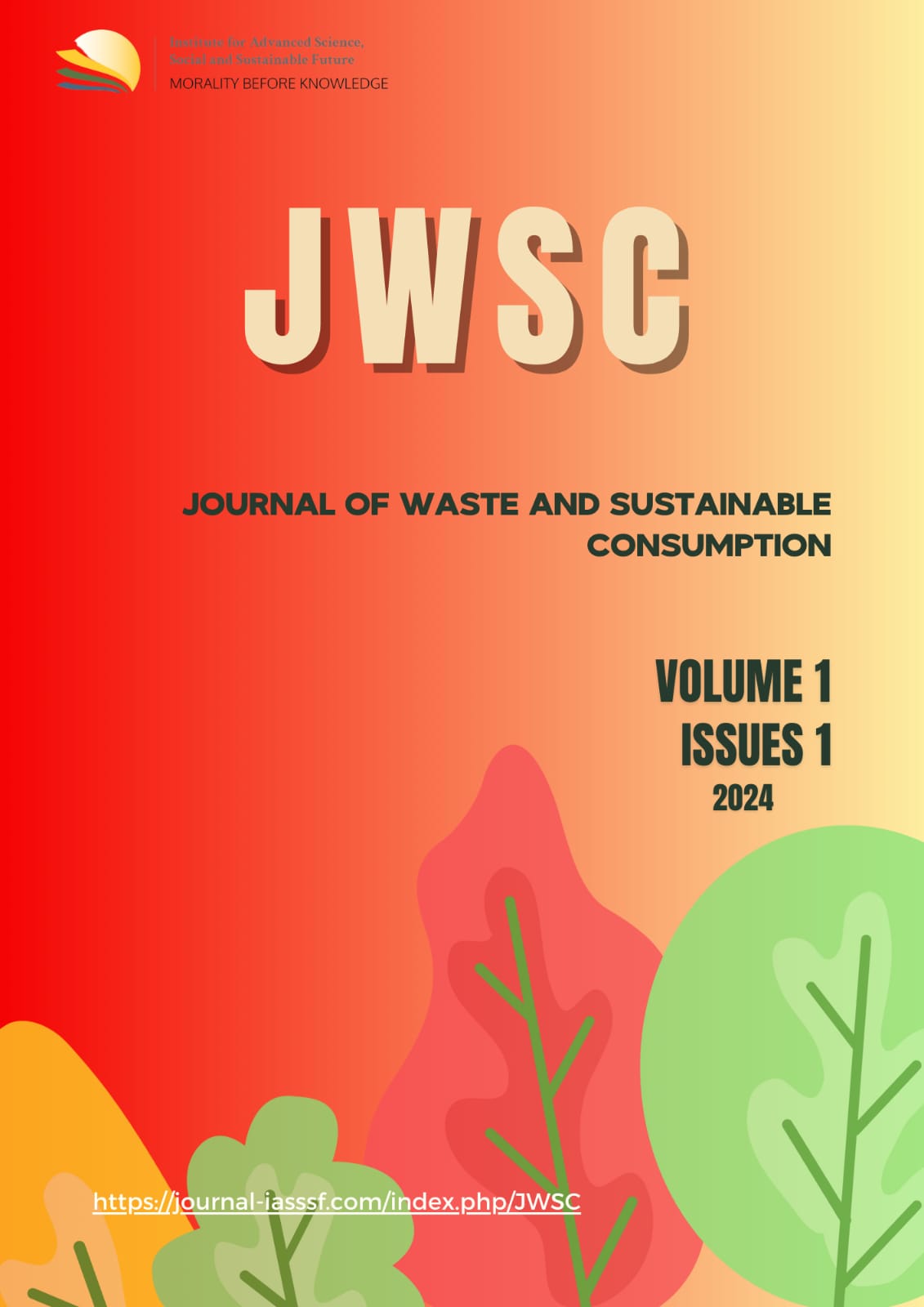The effect of industrial waste on air pollution and water pollution causes climate change
DOI:
https://doi.org/10.61511/jwsc.v1i1.2024.668Keywords:
air pollution, climate change, industry, water pollutionAbstract
Background: Industrial pollution refers to any type of contamination that results directly from industrial operations. The majority of the pollution on this planet is also caused by various industries. The environment is greatly impacted by this pollution. Industrial pollution can degrade soil quality, taint sources of drinking water, and emit pollutants into the atmosphere. Energy and industrial pollution are intimately intertwined. Energy can transform from one form to another, and these changes can have a variety of effects on the surrounding area and the air we breathe. The main source of pollution is combustion, which transforms the chemical energy in fossil fuels into heat, mechanical, or electrical energy. So the biggest sources of air pollution are power plants, cars, and stoves. The pollutants released are often divided into three categories: carbon monoxide (CO), nitrogen oxides (NOx), and hydrocarbons (HC) (CO). Smog, acid rain, global warming, and climate change are mostly caused by pollutants released by the burning of fossil fuels. Future life is impacted by climate change. Deforestation, or the loss of green forest ecosystems, is one of the causes of global warming. This is because it ignores the consequences of industrial opening and changes in land use brought on by population increase. Environmental issues including air pollution and water pollution are significantly impacted by pollutants produced by the industrial sector. This research explains the effect of industrial waste on air pollution and water pollution. Methods: The research method used is a secondary method, namely research that involves the use of existing data. The sources in this study were taken from journals related to the effect of industrial waste on air pollution and water pollution which are one of the causes of climate change. Findings: At both the national and international levels, legislation and regulations have been implemented that take this environmental concern into consideration. Conclusion: The issue of climate change is related to reducing greenhouse gas (CO2) emissions at the international level, for instance in the energy sector. This is done within the framework of the United Nations, specifically the Climate Change Convention outlined in the Kyoto Protocol, which requires ratifying countries to reduce CO2 emissions to an agreed-upon target.
References
Astra, I. M. (2010). Energi dan dampaknya terhadap lingkungan. Jurnal Meteorologi dan Geofisika, 11(2), 131-139. https://www.academia.edu/download/84853813/66.pdf
Wahyuni, H., & Suranto, S. (2021). Dampak deforestasi hutan skala besar terhadap pemanasan global di Indonesia. JIIP: Jurnal Ilmiah Ilmu Pemerintahan, 6(1), 148-162. https://ejournal2.undip.ac.id/index.php/jiip/article/download/10083/5327
Ismail, A. (2020). Potensi Penurunan Emisi Gas Rumah Kaca (Grk) Dalam Kegiatan Belajar Di Rumah Secara on-Line: Analisis Jejak Karbon (Carbon Footprint Analysis). Jukung (Jurnal Teknik Lingkungan), 6(2). https://ppjp.ulm.ac.id/journal/index.php/jukung/article/download/9262/6543.
Ridwan, I. R. (2016). Dampak industri terhadap lingkungan dan sosial. Jurnal Geografi Gea, 7(2). https://ejournal.upi.edu/index.php/gea/article/viewFile/1716/1166
Putri, A. M., Abbas, D. S., & Rachmania, D. (2023). Pengaruh Ukuran Perusahaan, Profitabilitas, Dan Leverage Terhadap Enviromental Disclosure. Jurnal Akuntan Publik, 1(4), 125-137. https://journal.widyakarya.ac.id/index.php/jap-widyakarya/article/download/1680/1649
Budiyono, A. (2010). Pencemaran udara: dampak pencemaran udara pada lingkungan. Berita Dirgantara, 2(1). https://jurnal.lapan.go.id/index.php/berita_dirgantara/article/viewFile/687/605
Widiyanto, A. F., Yuniarno, S., & Kuswanto, K. (2015). Polusi air tanah akibat limbah industri dan limbah rumah tangga. Jurnal Kesehatan Masyarakat, 10(2), 246-254. https://journal.unnes.ac.id/nju/kemas/article/viewFile/3388/3300
Sulistina, D. R. (2018). Polusi Air Dan Resiko Pada Lingkungan Dunia.
Tainio, M., Andersen, Z. J., Nieuwenhuijsen, M. J., Hu, L., De Nazelle, A., An, R., ... & de Sá, T. H. (2021). Air pollution, physical activity and health: A mapping review of the evidence. Environment international, 147, 105954. https://doi.org/10.1016/j.envint.2020.105954
P. P. Ekonomi, I. Pengolahan, and T. Kualitas. (2022). CO2 Di Indonesia.
Abidin, J. & Hasibuan, F. A. (2019). Pengaruh Dampak Pencemaran Udara Terhadap Kesehatan Untuk Menambah Pemahaman Masyarakat Awam Tentang Bahaya dari Polusi Udara. Seminar Nasional Fisika Universitas Riau IV, 3002:1-7. https://snf.fmipa.unri.ac.id/wp-content/uploads/2019/09/18.-OFMI-3002.pdf
Resosudarmo, B. P., Mahi, B. R., Kuncoro, A., & Handayani, S. B. (1997). Emisi polusi udara dan air sungai dalam struktur industri Indonesia. Development, 25(3). http://people.anu.edu.au/budy.resosudarmo/1996to2000/IOLing_2000.pdf
Kwanda, T. (2003). Pembangunan permukiman yang berkelanjutan untuk mengurangi polusi udara. DIMENSI (Journal of Architecture and Built Environment), 31(1). https://ojs.petra.ac.id/ojsnew/index.php/ars/article/download/15783/15775
Purba, J. T., & Budiono, S. (2019). Fixed Effects Modeling: Strategi Pembangunan Sumber Daya Manusia dengan Ketercukupan Air Bersih di Indonesia. Business Knowledge to Be Elevated: Advancing Disruptive Innovation. Tangerang, Indonesia: Universitas Pelita Harapan. https://www.researchgate.net/profile/John-Purba/publication/337974907_Fixed_Effects_Modeling_Strategi_Pembangunan_Sumber_Daya_Manusia_dengan_Ketercukupan_Air_Bersih_di_Indonesia/links/5df8cc22299bf10bc3615faf/Fixed-Effects-Modeling-Strategi-Pembangunan-Sumber-Daya-Manusia-dengan-Ketercukupan-Air-Bersih-di-Indonesia.pdf
Ameilia, D., Sugiyanta, I. G., & Nugraheni, I. L. (2018). Analisis Kualitas Air Tanah Dangkal Untuk Keperluan Air Minum di Desa Pematang. JURNAL PENELITIAN GEOGRAFI. http://repository.lppm.unila.ac.id/51435/1/15585-34935-1-PB.pdf
Dirgapraja, V. A., Poluan, R. J., & Lakat, R. S. (2019). Pengaruh Pengembangan Kawasan Industri Terhadap Permukiman Kecamatan Madidir Kota Bitung. Spasial, 6(2), 282-290. https://ejournal.unsrat.ac.id/index.php/spasial/article/download/25310/24996
Downloads
Published
Issue
Section
Citation Check
License
Copyright (c) 2024 Journal of Waste and Sustainable Consumption

This work is licensed under a Creative Commons Attribution 4.0 International License.













